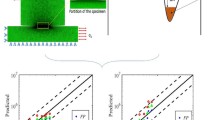Abstract
In order to find out a physical quantity which controls the fatigue life of a structure and to predict the fatigue life of tires, a finite element simulation methodology to use the cracking energy density (CED) and the virtual crack closure technique (VCCT) was proposed and applied to three different tires of a similar size. CED was calculated to predict the location of a crack initiation, and VCCT was used to obtain the strain energy release rate (SERR) at the tip of an initiated crack. Finite element simulations showed that SERR oscillated in the circumferential direction with its minimum occurring just before the contact zone and its maximum occurring just after the center of the contact zone, and SERR was affected significantly by the frictional force acting on the crack surface. In addition, a durability test was conducted to measure the fatigue life of the three tires. The comparison of SERR values with the test data revealed that the fatigue life increased as the amplitude of SERR decreased or as the R-ratio of SERR increased.
Similar content being viewed by others
References
Beatty, J. R., 1964, “Fatigue of Rubber,”Rubber Chemistry and Technology, Vol. 37, pp. 1341–1364.
Choi, J. -H., Kang, H. -J., Jeong, H. -Y., Lee, T. -S. and Yoon, S. -J., 2005, “Heat-Aging Effects on the Material Property and the Fatigue Life of Vulcanized Natural Rubber, and Fatigue Life Prediction Equations,”Journal of Mechanical Science and Technology, Vol. 19, No. 6, pp. 1229–1239.
DeEskinazi, J. and Ishihara, K., 1990, “Towards Predicting Relative Belt Edge Endurance with Finite Element Method,”Tire Science and Technology, TSTCA, Vol. 18, No. 4, pp. 216–235.
Ebbott, T. G., 1996, “An Application of Finite Element-Based Fracture Mechanics Analysis to Cord-Rubber Structure,”Tire Science Technology, TSTCA, Vol. 24, No. 3, pp. 220–235.
Feng, X. and Yan, X., 2004, “Analysis of Extension Propagation Process of Interface Crack between Belts of a Radial Tire Using a Finite Element Method,”Applied Mathematical Modelling, Vol. 28, pp. 145–162.
Gent, N., 2001,Engineering with Rubber, 2nd edition, HANSER, Cincinnati, pp. 137–176.
Grosh, K., 1987, “Rolling Resistance and Fatigue Life of Tires,”Rubber Chemistry and Technology, Vol. 61, pp. 43–63.
Irwin, G. R., 1957, “Analysis of Stresses and Strains Near the End of a Crack Traversing a Plate,”Journal of Applied Mechanics, Vol. 24, pp. 361–364.
Kim, T. -W., Jeong, H. -Y., Choe, J. -H. and Kim, Y. -H., 2005, “Prediction of the Fatigue Life of Tires Using CED and VCCT,”Key Engineering Materials, Vol. 297-300, pp. 102–107.
Legorju-jago, K. and Bathias, C., 2002, “Fatigue Initiation and Propagation in Natural and Synthetic Rubbers,”International Journal of Fatigue, Vol. 24, pp. 85–92.
Liebowitz, H. and Moyer, E.T., 1989, “Finite Element Methods in Fracture Mechanics,”Cornput. Struct, Vol. 31, No. 1, pp. 1–9.
Lindley, P. B., 1974, “Non-Relaxing Crack Growth and Fatigue in a Non-Crystallizing Rubber,”Rubber Chemistry and Technology, Vol. 47, pp. 1253–1264.
Mars, W. V., 2001, “Multiaxial Fatigue Crack Initiation in Rubber,”Tire Science and Technology, TSTCA, Vol. No. 3, pp. 171–185.
NHTSA, ODI, 2001, “Engineering Analysis Report and Initial Decision Regarding EA00-023: Firestone Wilderness AT Tires.”
Rice, J., 1968, “A Path Independent Integral and the Approximate Analysis of Strain Concentration by Notches and Cracks”,Journal of Applied Mechanics, Vol. 35, pp. 379–386.
Ro, H. S., 1989,Modeling and Interpretation of Fatigue Failure Initiation in Rubber Relater to Pneumatic tires, Ph.D. Dissertation, Purdue University.
Roach, J. F., 1982,Crack Growth in Elastomers under Biaxial Stresses, Ph.D. Dissertation, University of Akron.
Roberts, B. J., 1977, “The Relationship between Uniaxial and Equibiaxial Fatigue in Gum and Carbon Black Filled Vulcanizates,”Proceedings of Rubbercon’77, Vol. 2.1, pp. 2.1–2.13.
Rybicki, E. F., 1977, “A Finite Element Calculation of Stress Intensity Factors by A Modified Crack Closure Integral,”Engineering Fracture Mechanics, Vol. 9, pp. 931–938.
Shivakumar, K. N., 1988, “A Virtual Crack Closure Technique for Calculating Stress Intensity Factors for Crack Three Dimensional Bodies,”International Journal of Fracture, Vol. 36, pp. R43-R50.
Treloar, L. R. G., 1958,Physics of Rubber Elasticity, Oxford University Press, London
Wei, Y. -T., Tian, Z. -H., and Du, X. W., 1999, “A Finite Element Model for Rolling Loss Prediction and Fracture Analysis of Radial Tires,”Tire Science Technology, TSTCA, Vol. 27, No. 4, pp. 250–276.
Yan, X. and Wang, Y., 2002, “Study for the Endurance of Radial Truck Tires with Finite Element Modeling,”Mathematics and Computers in Simulation, Vol. 59, pp. 471–488.
Author information
Authors and Affiliations
Corresponding author
Rights and permissions
About this article
Cite this article
Park, K.S., Kim, T.W., Jeong, H.Y. et al. Consideration of the frictional force on the crack surface and its implications for durability of tires. J Mech Sci Technol 20, 2159–2167 (2006). https://doi.org/10.1007/BF02916332
Received:
Revised:
Issue Date:
DOI: https://doi.org/10.1007/BF02916332




